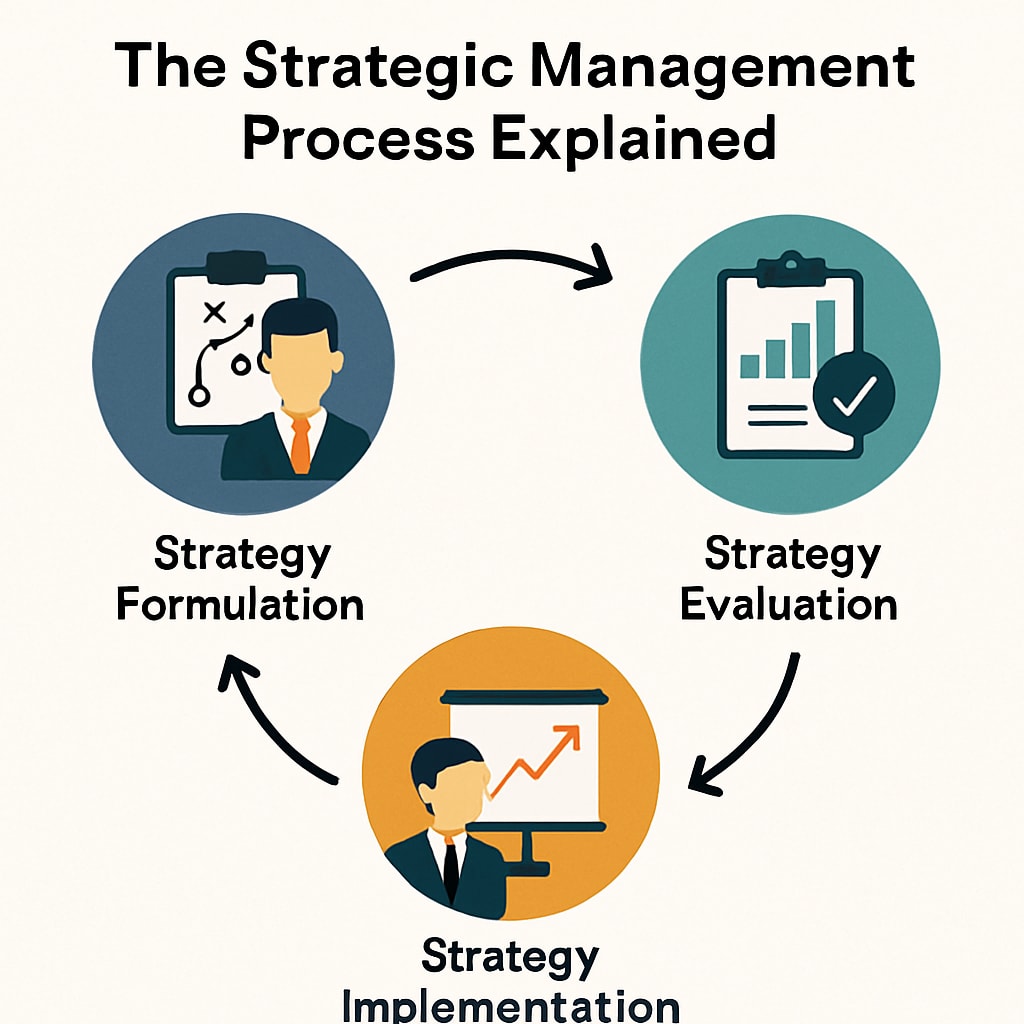What Is Strategic Management? Benefits, Process, and Types
Table of Contents

Let’s think about the most successful companies in the world—Apple, Netflix, and Amazon. What is their common thread? It’s not luck; it’s a powerful practice known as strategic management. In a world where 9 out of 10 startups vanish, knowing how to formulate a strategy can position your business to survive and thrive. This blog will unpack strategic management, outlining the benefits of strategic management, the process, and different types of strategic management. We will show you how strategic management can support you to navigate today’s complex market and exist successfully beyond.
What is Strategic Management?
Strategic management means looking ahead. It’s not only about addressing today’s problems but also those of tomorrow. Essentially, it helps a company declare its purpose, know its competitors, and set its destination. It provides the framework to build a roadmap, which signifies that every employee and every department is on the same page; cohesion breeds focus and provides a competitive edge. Think of the company as a ship adrift in the ocean, with no clear direction. Now, consider the company as a ship, sailing with a clear destination and a skilled Captain.
The Strategic Management Process Explained
The strategic management process is a never-ending cycle of planning, implementation, and assessment that an organization employs to achieve long-term goals. This is a proactive approach that enables the organization to respond to changes in its external and internal environments, thereby increasing its chances of being competitive and successful.
The 3 Main Stages of the Process
This process is generally categorized into three main stages; each stage is a part of a loop that must be realized in the process of strategic management, as strategy remains fluid.

- Strategy Formulation: This is the stage of planning. During this stage, the organization defines its mission, vision, and objectives. This involves a thorough environmental assessment, which focuses on the organization’s strengths, weaknesses, opportunities, and threats (commonly known as a SWOT analysis). The leadership team then uses the SWOT information to develop a specific, long-term direction for the company regarding what markets to compete in, what products to offer, and how to compete in the marketplace.
- Strategy Implementation: This is the action stage. After a strategy has been formulated, it must be put into motion. This requires decisions and actions associated with the diffusion of resources, organization composition, and the culture of the organization to support the strategy. As implementation relies on the collective effort to achieve company objectives, it needs to be imbued with a proficient effort in the use of leadership, management of people, organization of resources, and effective communication so that each employee has an optimal understanding of their respective roles to maximize the company objectives.
- Strategy Evaluation: This is the stage of monitoring. A strategy can only be effective if it’s working. In the stage of strategy evaluation, a company is comparing its performance against its goals. This is done through an evaluation of both internal and external factors, key performance indicators (KPIs), and external compliance. A strategy is a work in progress, continually receiving feedback. This loop establishes the base for the company to adjust toward and bring it back on track. This feedback is constantly evaluated, even if there is no external change, because the goal itself could be unexpected.
Why is Strategic Management Important for Business Growth?
Strategic management is essential for cultivating business growth because it serves as the pathway to success for any company. Without strategic management, a business is merely responding to situations instead of taking the proactive initiative. Essentially, it’s the difference between existing as a business and growing as a business.
Gaining a Competitive Advantage
In most industries today, it is imperative for a business to instill in its employees to be one step ahead of its competitors. Organizations today rely on organized, strategic management to help their businesses carefully analyze each market segment, take the business’s strengths from market analysis, and develop a plan to proactively build those strengths into their business model. This is achieved through organizational excellence, examining the weaknesses of competitors, and developing strategies (either by acquiring a unique product, exceptional customer experience, or producing more efficiently) to disrupt the market and develop a sustainable competitive advantage.
Focus Efforts and Resources
Determining the appropriate strategic plan to achieve your desired company goals enables you to motivate everyone, from leadership to staff, to work toward that objective. This will limit waste to the organization from employees (of either money, time, or talent) on activities that are not aligned with your company’s goals for long-term vision. Mobilizing the resource allocation to the mix of things that will likely have the most impact by improving operational effectiveness and return on investment to build ongoing growth.
Adapting to Change and Reducing Risk
Change is consistently present in the business world, whether from advancing technology, shifting consumer demands, or changing economic conditions. As a dynamic process, strategic management provides a framework for a company to look ahead and prepare for change. By regularly auditing business performance and evaluating the current market, the company can scan for changes and potential threats to the business and the industry in which it operates. This early detection allows the company to adapt and adjust its strategy sooner and help mitigate risk, and put itself in a better position to take advantage of any new trends that might be occurring.
The Key Benefits of Strategic Management
Consider the benefits of strategic management as the master ingredient in the development of a company. It is more than just a cool business word; it is an actual structure that provides a business with a true, tangible differentiation. With a strong strategy, a company can be rewarded for more than just focusing on what to do on a particular day, with fabulous rewards contributing to growth and success.

- Better Decisions
When a company doesn’t have a strategy, it tends to make quick decisions or react to its competitors, which can lead to inconsistent outcomes and unintended waste. Strategic management provides a straightforward business direction or a strategy with guiding principles that dictate expected business actions. When a company adopts strategic management, one has the means to ensure each major decision (i.e., launching a new product, expanding into new markets, etc.) aligns with the company’s long-term plans/vision. In other words, strategic management takes away the guesswork and leads to choices aimed at consistent and predictable success!
- More Proactivity, Less Reactivity
Most businesses spend their time concentrating on reacting to their competitors or the latest market changes. Strategic management works to reverse this situation. Organizations that adopt strategic management rethink the competitive landscape and where they may be in the future. A company focused on observing its competitors through strategic management will outpace its competitors every time that an opportunity exists. Strategic management offers business opportunities to engage in innovative practices, change, and respond to opportunities with an ability to identify business opportunities that competitors do not even see coming!
- Better Employee Alignment and Motivation
When employees are on the same page as the company’s strategy, they have a stronger sense of purpose. A well-written strategic management plan explains the objectives of the company while clarifying each component and what each person does to support the objectives of the company. This also develops a more motivated and engaged employee base, as employees will recognize they are supporting the success of a mission they care about.
- Effective Use of Resources
All businesses have limitations on their resources, be they capital, time, talent, or any other component in the business. A good strategy serves as a lens to help the company filter together all of its initiatives and assists the company in ensuring that it can concentrate attention on the initiatives that return the best return on investment. This focus on the most important initiatives helps to ensure that we do not stretch ourselves too thin on low-priority initiatives. Instead, we can focus much of our precious limited resources on the initiatives that really matter relative to achieving the strategic objectives of the company, and help to ensure the company is getting the most effective use of its limited resources while growing quicker than it would otherwise.
Exploring the Different Types of Strategic Management
To truly grasp the types of strategic management, you must understand that its activities operate at multiple levels in an organization. Strategic management does not take a one-size-fits-all approach but instead provides a layered structure that keeps every aspect of the organization—from top management to individual departments—aligned with the various strategies the company is pursuing to achieve its goals. This multi-level effort is the true power of a strategy and establishes the company’s competitive advantage.
1. Corporate-Level Strategy: The Big Picture
The corporate level of strategy is the highest level of strategy, wherein the company executives—the CEO, board of directors, and senior-level managers—make decisions that affect the whole organization. The corporate-level strategy answers the question, “What business should we be in?”
Focus: The company vision, mission, and general scope. These strategies are concerned with major decisions such as mergers and acquisitions, diversifying into additional markets, and divesting from underperforming divisions.
Example: A beverage company’s corporate-level strategy of diversification will include decisions about how its portfolio of businesses will create value. When Coca-Cola began acquiring and developing bottled water, juices, and coffee products, it was acting on its corporate-level strategy of diversification.
2. Business-Level Strategy: How to Compete
This level deals with a specific business unit or product line in a company and asks the question, “How do we compete in this market?” This is where companies develop their competitive advantage.
- Focus on positioning the business against competitors. There are three classic approaches to a business-level strategy:
- Cost Leadership: To be the low-cost producer in the industry (e.g., Walmart).
- Differentiation: To offer a unique product or service that customers will pay a higher price for (e.g., Apple’s emphasis on how a product looks and whether it is easy to use).
- Focused strategy: Focus on a narrowly defined market segment, while being the low-cost provider or differentiator in that market segment (e.g., a luxury car brand).
An Example: Amazon’s e-commerce business unit uses a business-level strategy as part of its corporate strategy. Based on cost leadership and differentiation as it relates to its Prime service.
3. Functional-Level Strategy: The Action Plan
This is the most specific, granular level of strategic management. It addresses how each functional department—marketing, finance, human resources, operations, etc.—contributes to the corporate and business-level strategies. It answers the question, “How do we hit our plan in our department?”
Focus on: Day-to-day activities and tactical plans. A functional strategy makes sure that all functional departments’ actions are aligned with the focus.
Example: If the business-level strategy for the corporation is differentiation, the marketing department’s functional strategy might be to run premium ad campaigns, while the R&D department’s functional strategy might simply be to innovate as much as possible.
Real-World Examples of Strategic Management in Action
Although the theory of strategic management has a strong framework, its actual worth can be perceived through an example. It is also rather useful to study the examples of the companies that have managed to employ strategy and use it to overcome certain obstacles, innovate, and gain dominance over the market. Let us examine the way the most successful businesses in the world have applied strategic management to stay successful.
Apple Differentiation Strategy
The one company that has greatly hinged its success on a strong differentiation strategy is Apple. Rather than undercutting the price, Apple‘s strategic management has continually worked towards influencing the development of a coherent ecology, where its products are both technologically sophisticated and aesthetically appealing and incredibly convenient to use.
Corporate-Level Strategy Statement: Be the personal technology leader. Apple was strategic in product diversification, where it made a transition of its products beyond computers (Macs) to music players (iPods), smartphones (iPhones), and wearables (Apple Watches).
Business-Level Strategy: Differentiation. The products of Apple are famous for being unique in terms of design and integration. This enables the firm to charge high prices and develop rabid brand loyalty.
Functional-Level Strategy: The advertising and retail concepts that the company uses are textbook material on this. Their flashy retail stores give customers a unique experience, and their advertising is aimed at the benefits and emotional attachment to the product rather than the specifications of the product.
The DVD-to-streaming transition at Netflix changes
Netflix offers an impressive example of how to change the strategy to a shifting market. The firm began by offering a DVD rental business, which competed with Blockbuster with an improved business model. But their leadership knew that the change towards digital streaming was coming and made a radical strategic shift.
Corporate-Level Strategy: Making the decision to abandon physical media and instead rely on streaming was an ambitious strategic step by Netflix that changed the way the company operates. It evolved to become a technology and content provider as opposed to a logistics company.
Business-Level Strategy: They applied a differentiation strategy through their subscription service that had an immense and ever-growing library of content. Their approach was a totally different manner of consuming media, and it gave them a huge competitive advantage.
Functional-Level Strategy: Netflix’s original content strategy is a significant element of its functional-level strategy. They used their spending power and billions of dollars to produce original movies and series, which created exclusive content that made them stand out among competitors, and decreased their dependency on third-party studios. This farsighted thinking enabled them to take over the streaming market.
Symbiosis Online MBA: Your Path to Strategic Management Mastery
Are you looking to move from being a manager to a leader who can help shape the direction of your organization? The Symbiosis Online MBA will allow you to achieve that! The MBA program is not just another course; it is an investment in your career! This program will provide you with advanced strategic management skills that will help you navigate the complexity of the current business environment. When you understand high-level decision-making and long-term planning, you will be able to lead with confidence and take your organization further.
Plan Your Career with Jaro Education’s Expert Guidance
Career planning is not something easy to take on; however, with the help of Jaro Education, thousands of professionals and students have used their advice and have managed to redesign their futures in India. Having a confirmed record of success, having already empowered more than 3 lakh learners, Jaro Education has established its name in career counseling and up-skilling. Their customized service, program matching to the industry, and collaborations with the leading universities ensure that each learner is given proper guidance regarding his/her goals, proficiencies, and competencies. Be it a fresh graduate or an employee aspiring to develop as a professional, Jaro has career counsellors and carefully selected online courses that will help you ‘discover the right career.’ Jaro Education, with a staggering 85 percent career transition and placement record, strives to be the starting place of thousands of people in their attempt to create a successful career in the present competitive job environment.
Frequently Asked Questions
What is the difference between strategic management and strategic planning?
This question clarifies a common point of confusion for students and new professionals. It allows for an explanation of how planning is a part of the larger, continuous cycle of strategic management.
What are the key elements of a strategic management process that lead to business growth?
This query links the process directly to the outcome of “business growth.” It’s an opportunity to detail the key steps like environmental analysis, strategy formulation, and implementation.
How does strategic management apply to small businesses, not just large corporations?
This question targets a specific audience—small business owners. You can explain how the principles of strategic management are scalable and just as important for a startup’s survival and growth.
What are the key benefits of strategic management in a rapidly changing market?
This question highlights the dynamic nature of today’s business world. You can focus on benefits like adaptability, competitive advantage, and risk mitigation.
Why is strategic management important for employee alignment and motivation?
This query focuses on the human resources aspect of strategy. You can explain how a clear strategy gives employees a sense of purpose and helps them understand their role in the company’s success.
Recent Blogs
It seems we can't find what you're looking for.















